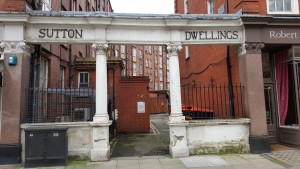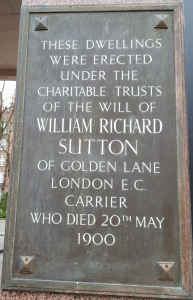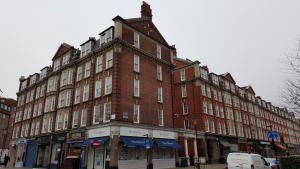Planning Application PP/15/04878
THE CHELSEA SOCIETY’S POSITION
The Constitution of the Chelsea Society provides that its Objects shall be to preserve and improve the amenities of Chelsea particularly by:- (a) stimulating interest in the history, character and traditions of Chelsea; (b) encouraging good architecture, town planning and civic design, the planting and care of trees, and the conservation and proper maintenance of open spaces; (c) seeking the abatement of nuisances; and (d) making representations to the proper authorities on these subjects.
An important amenity of Chelsea has, for the past 100 years or more, been social housing for those who cannot afford market rents and who in recent years have qualified for housing by the local authority. Associated with this has been the provision of estates and buildings which have become part of the fabric of Chelsea. The Society recently published a report of the history of social housing in Chelsea which can be found at: https://chelseasociety.org.uk/wp-content/uploads/2015/10/shr.pdf
The William Sutton Estate is a large estate bounded by Cale St., Elystan St., Marlborough St. and Ixworth Place. It was built in the early 20th century to provide housing for people with very limited incomes. The Society has during 2015 met with campaigners and also with a Director of Affinity Sutton and its project manager. Further, the Society’s Planning Committee has met specifically to consider this important Application. The Society is not for the tenants and against Affinity Sutton nor vice versa.
In summary, the Society’s position is that this planning application should be refused on the grounds that:
1. The architectural style of the proposed replacement buildings is bland and lacking character
2. The proposal fails to maintain, in terms of number of units and floor space, a sufficient amount of accommodation for social housing.
3. There are several major proposals for development in Chelsea – Sutton Estate, Royal Brompton and Royal Marsden Hospitals, Crossrail2, and Thamesbrook. The Society believes that these cannot be considered separately and that the Borough Council should prepare a planning brief for the whole area. All these proposals need to be seen together in terms of aesthetics and phasing of development. In particular St. Luke’s Church is a Grade 1 listed building, and there is a real danger that a piecemeal approach would compromise its context.
The Society views the Application relating to the Sutton Estate in two broad categories: 1. The Buildings, and 2. The present and future occupation of the Estate.
THE BUILDINGS
The Application relates to the existing Sutton Estate Blocks A-D, E, F, G, H, I, J, K, N & O. The Society notes with approval that the Application does not include blocks L and M with frontage to Cale Street and Elystan Street. These are fine examples of the architecture of the Edwardian period, and it is right that they should be preserved. They are the dominant feature of Chelsea Green, and they include small retail units which are important to the local community.
With regard to the remaining residential blocks, The Society wishes to ensure that the future land-use within the estate and the design of any new buildings should be compatible with the character, the style and the charm of Chelsea, but there are two points of view within the Society about the existing buildings. Some agree with the Victorian Society they are “a handsome well detailed series of mansion blocks in a Queen Anne style by ECP Monson, the architect of the listed Islington Town Hall” and that they ought to be preserved. Others believe that the mass of these buildings, and their close proximity to each other have a forbidding presence, in common with Edwardian prisons and barracks and that they should be replaced by buildings and open space which are more suitable for 21st century living. There is however broad agreement with the Victorian Society that the “proposed replacement buildings are bland, and lack the character of the 1913 buildings.”
The redevelopment of the Sutton Estate is a hugely important project, not only for Affinity Sutton and their tenants, but for everyone who values the character, the style, and the charm of Chelsea. If redevelopment is permitted we would therefore expect RBKC to require a much higher standard of architecture than is presently proposed, and we would be willing to be involved in the process. We would also expect strict controls on construction work and construction traffic in order to minimise the impact on local people.
THE OCCUPIERS
The Society is committed to maintain the mixed community of Chelsea which is such an important part of its character traditions and heritage. William Sutton gave the land and buildings to house people who could not afford market rents, and his purpose survives to this day. The owner is now a Housing Association, Affinity-Sutton Homes, which is regulated by the Homes and Community Agency under the Housing Act 2004. It is responsible for managing all its assets to provide accommodation which meets the Government’s Decent Homes Standards.
We note with approval that Affinity Sutton is committed on page 3 of its Planning Statement to ensure that all its existing Tenants can remain on the Sutton Estate if they so wish.
However, those campaigning against the Application are concerned by the number of social housing units which have been left empty and deteriorating in recent years. They point out that the number of social rent homes to be demolished = 383 and the number of social rent homes proposed = 237 Total loss = 146 homes. Social housing floorspace to be demolished = 18,708 m2 - Social housing floorspace proposed = 16,142 m2 - Total loss = 2,566 m2.
It is common ground that very large sums of money need to be spent on this estate to bring it up to modern standards, whether by refurbishment and/or by rebuilding. It is also common ground that public money will not be made available for this purpose, and that the work can be financed only by selling parts of the estate as private housing, to people who can afford the very high land values which Chelsea currently commands. Clearly, the more private housing the more money available, but the smaller the area available for social housing.
The crux of the matter is therefore to strike a balance between these two competing concerns. Affinity Sutton have committed themselves on page 3 of their Planning Statement to an open-book financial appraisal, and the Society expects the Borough Council to make a detailed appraisal, so as to determine the maximum number of rented units which can reasonably be financed, and not simply to accept the number proposed by Affinity Sutton. In this connection, most of the people who live in Chelsea as their only home are willing to accept smaller accommodation than they would expect elsewhere, because they place a premium on living in Chelsea. This should apply equally to social housing and should be borne in mind by Affinity Sutton and RBKC when calculating the number of units which can be accommodated on the site. Also, as this will be subsidized housing in Chelsea it should not be permissible to sublet, nor to use the rented dwellings for short-term purposes such as AirB&B.
In our view, all the receipts derived by Affinity Sutton from sales of private units on the Sutton Estate should be used to build rented accommodation on the same site. We are aware that Affinity Sutton is a national Housing Association with a responsibility to provide decent housing for people throughout the country, but they could not expect the Chelsea Society to support a scheme which provides less than the optimum number of rented homes on the Sutton Estate in order that a financial surplus could be spent outside Chelsea.
The Society believes that Chelsea should continue to be a place where people of all income groups can live, and is very conscious of the pressures on housing generated by the influx of foreign money and the consequent increases in the capital and rental values of properties of all kinds. This pressure is being felt not only by people whose incomes are very limited, but also by the middle-income groups whose parents and grandparents have lived in Chelsea but can no longer afford to live here themselves. The Society is concerned for the future of both of these groups, and believes that rented accommodation should be provided on the Sutton Estate not just for those with the lowest incomes, but for the middle-income groups as well.
CONCLUSION
All of the above is however subject to the Government’s proposal to give to Housing Association tenants the right to buy their dwellings at a discount, and the Society has opposed this in its September 2015 Newsletter at https://chelseasociety.org.uk/wp- content/uploads/2015/08/chelsea_society_no42_web.pdf As Chelsea is such a desirable area it could well be that in the not–too-distant future all the dwellings on the Sutton Estate will have been bought, and lost therefore to social housing. It is true that many existing tenants would not be able to afford to buy – but there have been cases elsewhere where finance has been made available through commercial arrangements with third parties. The implications of “the right to buy” place the Chelsea Society in a difficult position. The Society wishes to ensure that the ideals of William Sutton for the provision of social housing in Chelsea be maintained, but new legislation may make that impossible.
Dated 23rd December 2015
D. J. W. Greenish Chairman for and on behalf of the Council of the Chelsea Society






